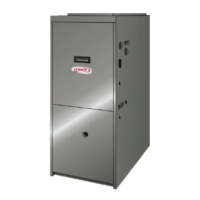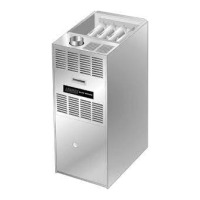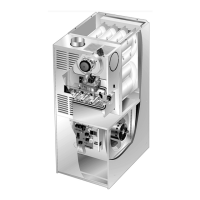Page 32
3. If exhaust piping must be run up a side wall to position
above snow accumulation or other obstructions, piping
must be supported every 3 feet (.9m) as shown in fig-
ure 18. Refer to figure 38 for proper piping method.
When exhaust piping must be run up an outside wall,
any reduction in exhaust pipe size must be done after
the final elbow.
FIGURE 38
12" (305) ABOVE
AVERAGE SNOW
ACCUMULATION
UNCONDITIONED
SPACE
1/2" (13) FOAM
INSULATION
1/2" (13) FOAM
INSULATION IN
UNCONDITIONED
SPACE
PROVIDE SUPPORT
FOR EXHAUST LINES
EVERY 36" (914)
OUTSIDE WALL
Inches(mm)
SIDE VIEW
NON−DIRECT VENT WALL RING TERMINATION
(15F74)
12" (305) Max. for 2" (51)
Unless Supported
SIZE TERMINATION
PIPE PER TABLE 15.
FIELD−PROVIDED
REDUCER MAY BE
REQUIRED TO
ADAPT LARGER
VENT PIPE SIZE TO
TERMINATION
NOTE − Do not discharge exhaust gases directly into any chimney or vent stack. If ver-
tical discharge through an existing unused chimney or stack is required, insert piping
inside chimney until the pipe open end is above top of chimney and terminate as illus-
trated. In any exterior portion of chimney, the exhaust vent must be insulated.
FIGURE 39
3" − 8"
(76mm−
203mm)
3" − 8"
(76mm−
203mm)
MINIMUM
12" (304mm)
ABOVE AVERAGE
SNOW ACCUMULATION
STRAIGHT−CUT OR
ANGLE−CUT IN DIRECTION
OF ROOF SLOPE
EXHAUST VENT
1/2" (13mm)
WEATHERPROOF
INSULATION
SHOULDER OF FITTINGS
PROVIDE SUPPORT
OF PIPE ON TOP PLATE
EXTERIOR
PORTION OF
CHIMNEY
INSULATE
TO FORM
SEAL
SHEET
METAL TOP
PLATE
MINIMUM 12"
(305mm) ABOVE
AVERAGE SNOW
ACCUMULATION
SIZE TERMINATION
PIPE PER TABLE 15.
G51MP NON−DIRECT VENT APPLICATION
USING EXISTING CHIMNEY
Condensate Piping
This unit is designed for either right- or left-side exit of con-
densate piping in either upflow or downflow applications;
however, it must be installed on the same side of the unit as
the exhaust piping . In horizontal applications, the conden-
sate trap should extend below the unit. A 5−1/2" service
clearance is required for the condensate trap. Refer to fig-
ure 40 for condensate trap locations.
FIGURE 40
CONDENSATE TRAP LOCATIONS
(Unit shown in upflow position)
Horizontal
left and
optional
downflow
Horizontal
right and
optional
downflow
Optional
upflow
Optional
upflow
NOTE − In upflow applications where side return
air filter is installed on same side as the conden-
sate trap, filter rack must be installed beyond
condensate trap to avoid interference.
1 − Determine which side condensate piping will exit the
unit. Remove plugs from the condensate collar at the
appropriate location on the side of the unit.
NOTE − The condensate trap is factory−shipped with
two rubber O−rings and two rubber clean−out caps
installed. Check to make sure that these items are in
place before installing the trap assembly.
2 − Install condensate trap onto the condensate collar. Use
provided HI/LO screws to secure two upper flanges of
the trap to the collar. Use provided sheet metal screw to
secure bottom trap flange to side of unit. See figure 41.
NOTE − In upflow and downflow applications, condensate
trap must be installed on the same side as the exhaust pip-
ing. The optional Condensate Trap Alternate Location Kit #
7620M" is available for those installations where the trap
cannot be mounted on the same side as the exhaust.
CAUTION
DO NOT use a power driver to tighten screws which
secure condensate trap to cabinet. Screws should be
hand−tightened using a screw driver to avoid the pos-
sibility of damage to the trap assembly.
3 − Glue the field−provided coupling or pipe to the trap.
Install a tee and vent pipe near the trap.
NOTE − The condensate trap drain stubs (both sides)
have an outer diameter which will accept a standard
3/4" PVC coupling. The inner diameter of each stub will
accept standard 1/2" diameter PVC pipe.
NOTE − Vinyl tubing may be used for condensate drain.
Tubing must be 1−1/4" OD X 1" ID and should be at-
tached to the drain stubs on the trap using a hose
clamp.
